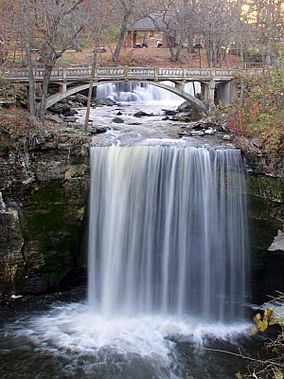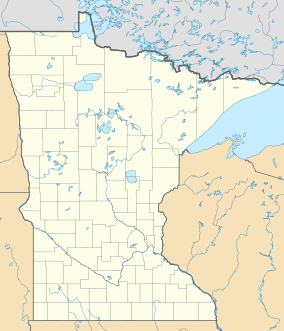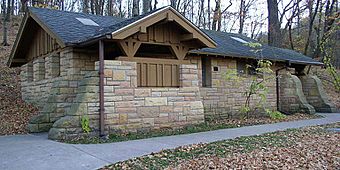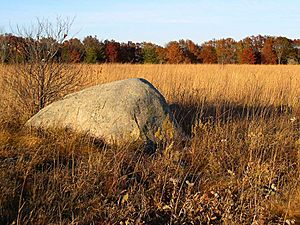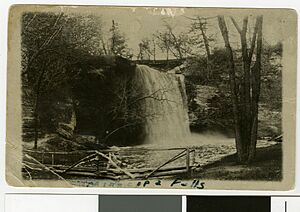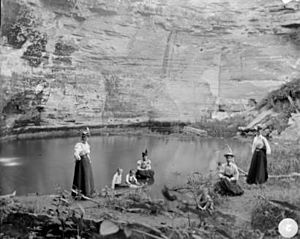Minneopa State Park facts for kids
|
||||||||||||||||||||||||||||||||||||||||||||
Minneopa State Park is a cool state park in Minnesota. It was created in 1905 to protect Minneopa Falls, a big waterfall for southern Minnesota. Later, the park grew to include more of Minneopa Creek and a large grassy prairie.
Minneopa is the third oldest state park in Minnesota. Only Itasca and Interstate are older. Two important places in the park are listed on the National Register of Historic Places. These are the 1862 Seppman Mill and several old buildings. These buildings were made by the Works Progress Administration (WPA) in the late 1930s.
The park is mostly on the south side of the Minnesota River. It's about three miles (4.8 km) west of Mankato. In 2015, American bison were brought back to the park. They live in a 330-acre (130 ha) fenced area. Visitors can drive through this area to see the bison up close!
Contents
Park Geography
Minneopa State Park is split into two main parts. Roads and private land separate them. The first part has the famous waterfalls and old WPA buildings. The second, larger part was added in 1969. It runs along the Minnesota River and has the campground and the Seppman Mill. You can travel between the two parts using a county road.
Minneopa Creek flows through the park. About 2.2 miles (3.5 km) upstream from where it meets the Minnesota River, the creek forms two waterfalls. The upper falls drop about 6 or 7 feet (2 m). Then the water flows 66 feet (20 m) before dropping over the 39-foot (12 m) lower falls.
The name Minneopa comes from the Dakota language. It means "water falling twice." Some people also say it means "water of two falls" or "water of the dancing elk." Minneopa Falls is often called the highest waterfall in southern Minnesota. However, Minnemishinona Falls in a nearby park is a bit taller at 42 feet (13 m). But Minneopa's lower falls are wider, at 25 feet (7.6 m) across.
The park has a continental climate. This means it has cold winters and hot summers. The areas near Minneopa Creek are a bit milder because of the many trees.
Park's Natural Wonders
Geology: Rocks and Glaciers
Minneopa State Park sits on flat layers of dolomite and sandstone. These are types of sedimentary rock. Underneath these layers, there's a tilted granite formation. Thick layers of dirt and rocks left by glaciers cover everything.
Long ago, when the last ice age ended, huge glaciers melted. The water formed a giant river called Glacial River Warren. This river carved out the wide valley you see today. As the water level dropped, it left flat areas like steps on the valley sides. This huge river stopped flowing about 9,400 years ago. The much smaller Minnesota River now flows in its place.
The flat prairie area in the park is one of these ancient river terraces. The Dakota people called it Tinta inya ota. This means "prairie with many rocks." You can see many large glacial erratics there. These huge boulders were carried by ice from far north over 15,000 years ago. The soil here is quite thin over the limestone rock.
Small streams flowing into the deep Minnesota River valley had to drop down, creating waterfalls. The waterfall on Minneopa Creek likely started at the river's edge. Over thousands of years, the creek has cut a deep gorge through the soft sandstone. This made the waterfall move upstream. Minneopa has two waterfalls because the sandstone has three layers. The top and bottom layers are softer than the middle one. This creates a short, harder section between the two falls. The gorge is full of broken pieces of the middle sandstone layer. The constant spray from the falls helps keep the gorge walls steep.
Flora: Plants and Trees
The park has many different kinds of plants. Before settlers arrived, it was mostly tallgrass prairie. There were also areas of Big Woods along Minneopa Creek and oak savanna at the east end. Along the Minnesota River, there was a bottomland hardwood forest. Today, many of these plant areas are still here. Much of the park land was too rocky or steep for farming.
The prairie area is about 355 acres (144 ha). It has junegrass and other grasses, forbs (flowering plants), and small eastern red cedars. Larger red cedars grow around the prairie. Some areas are being restored. For example, controlled burning helps the prairie grow better.
The valley sides of the river and creek have a northern hardwood forest. It covers about 273 acres (110 ha). You'll find sugar maple, basswood, elm, and northern red oak trees.
The bottomland forest has 170 acres (69 ha) of cottonwood, silver maple, and elm trees. The campground and picnic area are in an oak savanna. Here, large bur oaks are common.
The park has very few wetlands. Near the river, there's a 6-acre (2.4 ha) area with cattails and other water plants. Along the creek, there are 7 acres (2.8 ha) of wet meadow with different grasses and sedges.
Fauna: Animals and Wildlife
Minneopa State Park is home to many animals because it has different habitats. You'll often see white-tailed deer. Coyotes are often heard, even if you don't see them. Beavers live along the Minnesota River.
Over 213 types of birds have been seen in the park! These include bald eagles, red-tailed hawks, eastern bluebirds, and wild turkeys. Few fish live in the upper Minneopa Creek. But below the falls and closer to the Minnesota River, you can find many different fish.
Bison Reintroduction
American bison were brought back to the park in September 2015. This project helps increase the number of pure-bred bison in Minnesota. Before this, these bison were only in Blue Mounds State Park and the Minnesota Zoo. Minneopa was chosen because it already had a prairie. It also had good facilities and was close to many people and schools.
Eleven female bison were first released. By 2019, the herd grew to 30. Male bison are moved in and out to keep the herd genetically diverse. The park can hold about 40 bison. They roam in a 330-acre (130 ha) fenced area. Visitors can drive through this area on a road with special gates called cattle guards. You can also watch the bison from outside the fence.
Park's History
Early Days
People have lived in the Minneopa State Park area for thousands of years. Eight places with old stone tools have been found. There are also ancient burial mounds in the park. The first Europeans came in 1700. They were led by Pierre-Charles Le Sueur. They thought a special clay deposit had copper. They probably visited Minneopa Falls and hunted bison.
In 1853, the Treaty of Traverse des Sioux opened the area to white settlers. Some families built homes along Minneopa Creek. The towns of South Bend and Mankato were founded nearby. At this time, a group of Dakota people lived near Minneopa Creek. Their leader was Sintomniduta.
One story tells that Sintomniduta and his sister hid in a cave near the lower Minneopa Falls. This cave, known as Sintomniduta's Cave, collapsed around 1900. The Dakota people generally had good relationships with the settlers. Children from both groups often played together.
Becoming Popular

The beautiful falls became a very popular spot, especially on hot summer days. Artists and photographers made the falls famous across southern Minnesota. The first hotel for visitors opened in 1858. A famous artist, Robert S. Duncanson, visited in 1862 and painted Minneopa Falls. Also in 1862, Louis Seppmann started building his stone windmill nearby.
In the late 1860s, a railroad track was built along Minneopa Creek. The railroad built a train station at the falls. The station agent, J.B. Hodge, worked hard to promote Minneopa Falls. He convinced the railroad to advertise the park and offer cheap train tickets. Groups as large as 5,000 people came from big cities like Minneapolis and St. Paul. People also came by horse, wagon, and paddle steamer.
In 1870, a town called Minneopa was planned near the falls. It had a grain elevator, hotel, and shops. But after several years of grasshopper plagues, crops failed. The town was then abandoned.
The James-Younger Gang
The famous James-Younger Gang hid near Minneopa Creek in 1876. This was after their failed bank robbery in Northfield, Minnesota. They camped under the railroad trestle over Minneopa Gorge. They tried to hide with blankets, but they were spotted. Lawmen found their camp, but the gang escaped.
Bob and Jim Younger were hurt from the robbery. So the gang decided to split up. That night, Frank and Jesse James escaped on stolen horses. This was the last time the James-Younger Gang was together. The rest of the gang hid in the gorge for a few more days. They were later caught in a shootout near Madelia, Minnesota.
Becoming a State Park
Minneopa Falls had many owners after 1885. Even though it was popular, businesses there kept failing. By 1903, the owner thought about cutting down all the trees and using the land for cattle. Local people worried about losing access to the falls. They wanted it to be a public park.
A state representative, Ezra Gates, helped. He introduced a bill in 1905. People from Mankato worked hard to get the Minneopa State Park bill passed. It included $5,000 to buy and improve the land around the falls. The owner reluctantly sold 25 acres (10 ha) to the state. But with more public support, the park grew bigger the next year.
J.B. Hodge, the train station agent who loved promoting the falls, became the park's first superintendent. He made the gorge safer with cement steps and railings. He also added picnic tables. Over the years, other improvements were made, like a bridge and a picnic shelter. Locals cared a lot about the park. In 1927, a local board member even planted a black walnut orchard without telling the state first!
Park Development and Growth
Minneopa State Park was first focused on the falls. In 1931, the Seppman Mill was given to the park. This added a new part to the park that was not connected to the main area. During the Great Depression, federal money helped the park. From 1937 to 1940, young men from the Works Progress Administration (WPA) built new stairs, restrooms, and other buildings. They used local sandstone. A 58-acre (23 ha) area with seven of these old buildings is now on the National Register of Historic Places.
Minneopa State Park stayed quite small for a long time. It didn't have a campground and was mostly used by local people. In the 1960s, Minnesota was thinking about making many small state parks into county parks. Minneopa faced this change unless it could grow. Local groups again fought for the park. In 1967, the state got money and a federal grant for expansion.
The new land was bought mostly from the Seppmann family. It included more of Minneopa Creek and 3 miles (4.8 km) of the Minnesota River shore. This new land finally connected the Seppman Mill to the rest of the park. A campground, picnic area, and a road to the mill were soon built. The expanded park was officially opened in 1972. Volunteers also created hiking and skiing trails by 1977.
Fun Things to Do
Minneopa State Park has a campground with 61 spots. Six of these have electricity. There are also four group camps, each for up to 15 people, and a camper cabin. The park has three picnic areas and two picnic shelters.
You can hike on a 0.5-mile (0.80 km) trail around the falls. The northern part of the park has 4 miles (6.4 km) of trails. In winter, these trails are groomed for cross-country skiing. There isn't an official trail along the Minnesota River because floods often wash them away. A 2.5-mile (4.0 km) paved path connects Minneopa to Sibley Park in Mankato. This path is great for biking and walking.
You can go fishing along the river. You might catch channel and flathead catfish. Minneopa Creek below the falls also has fish you can catch.


